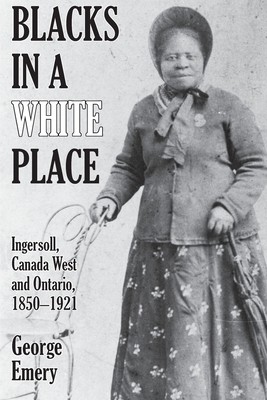
- We will send in 10–14 business days.
- Author: George Emery
- Publisher: Rock's Mills Press
- ISBN-10: 1772443255
- ISBN-13: 9781772443257
- Format: 15.2 x 22.9 x 1.6 cm, minkšti viršeliai
- Language: English
- SAVE -10% with code: EXTRA
Reviews
Description
In Blacks in a White Place, historian George Emery examines the lives of Blacks in Ingersoll, Ontario, during the years 1850 to 1921.During these years, Ingersoll---located in Oxford County, in the heart of Southwestern Ontario---was mostly a White-race place with a small Black-race minority. The number of Blacks peaked on the eve of the American Civil War, making up about 3 percent of the Ingersoll-area population. The Black population remained significant during the 1860s and 1870s, but then plummeted to 28 in Ingersoll and none in the townships by 1921.
Emery sets out to solve several mysteries. Why did Ingersoll have a large and growing Coloured population on the eve of the American Civil War? Why did its Black population largely vanish during the decades following? How did Blacks and Whites get along in Ingersoll before, during, and after the American Civil War---cordially or with friction?
Blacks in a White Place is about Blacks but also about how Ingersoll's White local historians interpreted them. The conventional wisdom based on their work regards Ingersoll's Black history as a by-product of American slavery before the Civil War and its abolition in 1863. Blacks came to Ingersoll, so the story goes, to escape oppression in Southern Slave States; they then returned to the "sunny South" once slavery was over (because of the severity of the Canadian winter climate, suggests one local historian). Ingersoll was a terminus of a White-assisted Underground Railway that spirited runaways from Southern Slave States to Northern Free States or to the sanctuary of Canada. Ingersoll Whites actively welcomed these refugees, giving them "a safe haven." In return, in 1854 grateful Blacks contributed free labour to help erect a White-abolitionist Wesleyan Methodist Church.
As Emery shows, upon further scrutiny this conventional narrative becomes problematic. The results of his investigations provide a clearer and more accurate picture of the lives of Blacks in the White place of Ingersoll, Ontario, in the second half of the nineteenth century.
EXTRA 10 % discount with code: EXTRA
The promotion ends in 23d.10:53:11
The discount code is valid when purchasing from 10 €. Discounts do not stack.
- Author: George Emery
- Publisher: Rock's Mills Press
- ISBN-10: 1772443255
- ISBN-13: 9781772443257
- Format: 15.2 x 22.9 x 1.6 cm, minkšti viršeliai
- Language: English English
In Blacks in a White Place, historian George Emery examines the lives of Blacks in Ingersoll, Ontario, during the years 1850 to 1921.During these years, Ingersoll---located in Oxford County, in the heart of Southwestern Ontario---was mostly a White-race place with a small Black-race minority. The number of Blacks peaked on the eve of the American Civil War, making up about 3 percent of the Ingersoll-area population. The Black population remained significant during the 1860s and 1870s, but then plummeted to 28 in Ingersoll and none in the townships by 1921.
Emery sets out to solve several mysteries. Why did Ingersoll have a large and growing Coloured population on the eve of the American Civil War? Why did its Black population largely vanish during the decades following? How did Blacks and Whites get along in Ingersoll before, during, and after the American Civil War---cordially or with friction?
Blacks in a White Place is about Blacks but also about how Ingersoll's White local historians interpreted them. The conventional wisdom based on their work regards Ingersoll's Black history as a by-product of American slavery before the Civil War and its abolition in 1863. Blacks came to Ingersoll, so the story goes, to escape oppression in Southern Slave States; they then returned to the "sunny South" once slavery was over (because of the severity of the Canadian winter climate, suggests one local historian). Ingersoll was a terminus of a White-assisted Underground Railway that spirited runaways from Southern Slave States to Northern Free States or to the sanctuary of Canada. Ingersoll Whites actively welcomed these refugees, giving them "a safe haven." In return, in 1854 grateful Blacks contributed free labour to help erect a White-abolitionist Wesleyan Methodist Church.
As Emery shows, upon further scrutiny this conventional narrative becomes problematic. The results of his investigations provide a clearer and more accurate picture of the lives of Blacks in the White place of Ingersoll, Ontario, in the second half of the nineteenth century.


Reviews